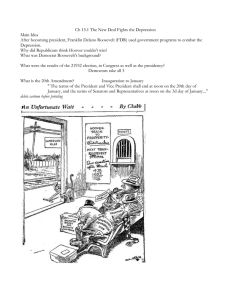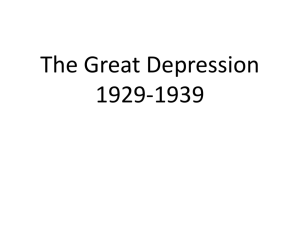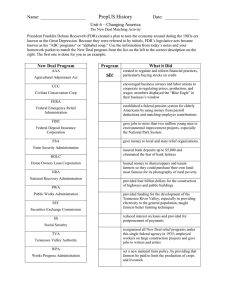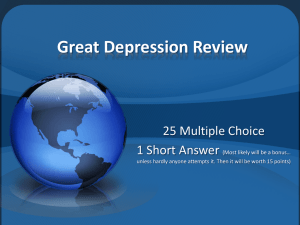Day 5 HW FDR Reading
advertisement
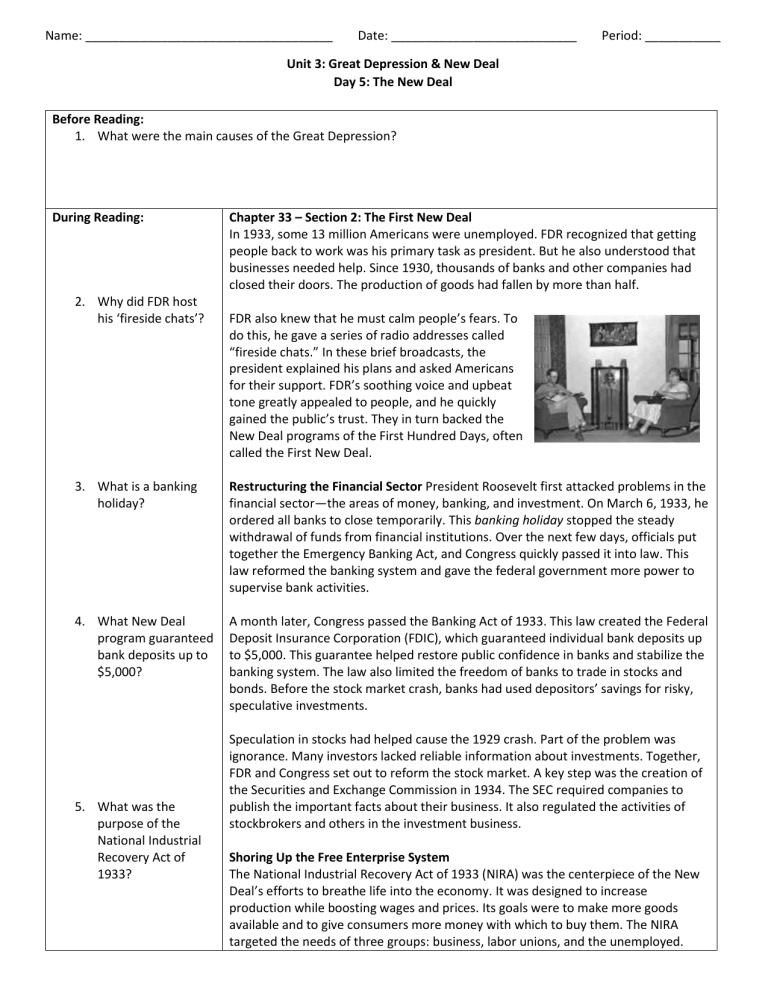
Name: ____________________________________ Date: ___________________________ Period: ___________ Unit 3: Great Depression & New Deal Day 5: The New Deal Before Reading: 1. What were the main causes of the Great Depression? During Reading: 2. Why did FDR host his ‘fireside chats’? Chapter 33 – Section 2: The First New Deal In 1933, some 13 million Americans were unemployed. FDR recognized that getting people back to work was his primary task as president. But he also understood that businesses needed help. Since 1930, thousands of banks and other companies had closed their doors. The production of goods had fallen by more than half. FDR also knew that he must calm people’s fears. To do this, he gave a series of radio addresses called “fireside chats.” In these brief broadcasts, the president explained his plans and asked Americans for their support. FDR’s soothing voice and upbeat tone greatly appealed to people, and he quickly gained the public’s trust. They in turn backed the New Deal programs of the First Hundred Days, often called the First New Deal. 3. What is a banking holiday? Restructuring the Financial Sector President Roosevelt first attacked problems in the financial sector—the areas of money, banking, and investment. On March 6, 1933, he ordered all banks to close temporarily. This banking holiday stopped the steady withdrawal of funds from financial institutions. Over the next few days, officials put together the Emergency Banking Act, and Congress quickly passed it into law. This law reformed the banking system and gave the federal government more power to supervise bank activities. 4. What New Deal program guaranteed bank deposits up to $5,000? A month later, Congress passed the Banking Act of 1933. This law created the Federal Deposit Insurance Corporation (FDIC), which guaranteed individual bank deposits up to $5,000. This guarantee helped restore public confidence in banks and stabilize the banking system. The law also limited the freedom of banks to trade in stocks and bonds. Before the stock market crash, banks had used depositors’ savings for risky, speculative investments. 5. What was the purpose of the National Industrial Recovery Act of 1933? Speculation in stocks had helped cause the 1929 crash. Part of the problem was ignorance. Many investors lacked reliable information about investments. Together, FDR and Congress set out to reform the stock market. A key step was the creation of the Securities and Exchange Commission in 1934. The SEC required companies to publish the important facts about their business. It also regulated the activities of stockbrokers and others in the investment business. Shoring Up the Free Enterprise System The National Industrial Recovery Act of 1933 (NIRA) was the centerpiece of the New Deal’s efforts to breathe life into the economy. It was designed to increase production while boosting wages and prices. Its goals were to make more goods available and to give consumers more money with which to buy them. The NIRA targeted the needs of three groups: business, labor unions, and the unemployed. To help business, the law set up the National Recovery Administration (NRA). This government agency worked with business leaders to create codes of fair competition in various industries. 6. What did FDR hope to do with these New Deal programs? 7. Why did the government pay farmers to stop farming? 8. How did the TVA help Americans? 9. How did the CCC help Americans? The NIRA established the Public Works Administration (PWA) to oversee construction projects. FDR hoped not only to create jobs but also to restart the economy with a large infusion of government cash. Unfortunately, the PWA spent its money so slowly that it had little effect on jobs or the economy. Paying Farmers Not to Plant Another piece of recovery legislation created the Agricultural Adjustment Administration (AAA).This agency tried to aid farmers by reducing crop production and raising prices. Many farmers also lost their farms because they were unable to pay their mortgages. To raise prices, the AAA paid farmers to plant fewer crops. In theory, this would reduce crop supplies and increase market demand, thereby boosting prices. The AAA also provided loans to farmers so they could pay their mortgages and stay on their land rather than join the jobless in cities. Promoting Economic Development and Homeownership In 1933, at the urging of the Roosevelt administration, Congress passed a bill creating the Tennessee Valley Authority. The TVA, an independent government agency, built a series of dams on the Tennessee River. These dams provided flood control and hydroelectric power to seven southern states. The TVA also battled erosion and deforestation, both processes that posed serious problems in the Tennessee Valley. In addition, this far-reaching program brought badly needed jobs to the region and encouraged businesses to invest there. Remembering the “Forgotten Man” During his campaign, FDR had promised to remember the “forgotten man.” Now, under the First New Deal, he carried out that promise by providing relief programs designed to help ordinary Americans as they struggled to survive the Depression. One important work-relief program was the Civilian Conservation Corps (CCC), which gave young men jobs planting trees and working on other conservation projects. A much larger program, the Federal Emergency Relief Administration (FERA), took an approach different from providing people with work. Instead, it sent funds to state governments, which then distributed the cash to the needy. For the first time in American history, a federal agency provided direct relief to the unemployed. State and local agencies also pitched in with supplies of food and clothing to help the poor. After Reading: 10. How did FDR try to help Americans during the Great Depression?
